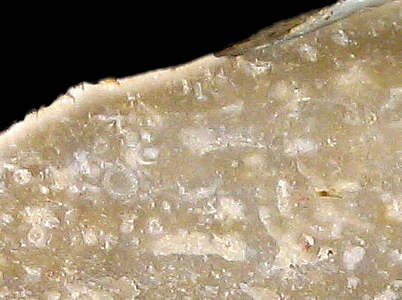
Foto: Jehanne Féblot-Augustins, 2005.
| Material name: | CN4b |
| Synonyms: | Silex Crétacé supérieur Nord - Sénonien |
| Material (geologic): | Late Cretaceous (senonian, Campanian) flint |

Foto: Jehanne Féblot-Augustins, 2005. |
| Mode of occurrence: | Large irregular or flattish nodules. |
| Cortex: | Thin, worn and smooth, to very rough and pitted, brownish yellow, transition sharp. |
| Colour: | Greyish brown to light brownish grey (2.5Y 5.5/2). |
| Pattern: | Alignments of white millimetric specks, occasional mottling on some of the samples. |
| Appearance: | Lacks homogeneity (bursts into small pieces), dull, semi-opaque, rough, coarse to medium-grained. |
| Structure: | Occasional fluidal arrangement of grains. |
| Texture: | Wackestone/packstone. |
| Matrix: | Subtranslucent. |
| Grains: | 25 to 30 %, pale, subangular with low to high sphericity (bryozoan sections), large-sized (1 to 5 mm). |
| Grain composition: | Mainly large colonial and ramified bryozoans, a few fragments of echinoderms and pelecypods. |
| Further information: | Click here for the original French description (opens in a new window), or here for more information on the attributes used in the description (use your browser's "BACK"-button to return here). |
| Citing: | Information on citing this page can be found here. |
| Locality: | Poncin / Chenavel - Chatanay, France, Ain department |
| Synonyms: | Sampling site Bugey 48 after Féblot-Augustins |
| Geographical description: | The sampling-site is located directly adjacent to a narrow road, a bit over a kilometre to the (S)SW of Poncin. |
| Geographical co-ordinates: |
east/x 836,7 to 836,8 north/y 2124 to 2124,2 (Lambert zone II, NTF)
This corresponds roughly with |
| Co-ordinate precision: |
As the site is a few hectares in size, precision is not of the highest importance, but the coordinates lie well within the area. The geographical coordinates point to a spot near the centre of the site. The location can be found on the 1:25 000 topographical map sheet 3230 W of the French Institut Géographique National. |
| Geology: |
The material from this site can be classified as surface-collected flint or in eroded gulleys, Chenavel sector, clays-with-flint of various geological origins (Early and Late Cretaceous); Unit S (Rs). Map of all sampled localities of Late Cretaceous flint in the Bugey (PDF, 54 KB, opens in new window). |
| Type of source: | Secondary. |
| Other types of flint: | Besides the Campanian CN4b material, several types of Late Cretaceous material can be found here (CN1a, CN2a, CN2c, CN4a, and CN6), as well as Early Cretaceous Ht3 flint. |
thumb.jpg) Foto: Jehanne Féblot-Augustins, 2005 |
thumb.jpg) Foto: Jehanne Féblot-Augustins, 2005 |
| Locality: | Poncin / La Bierle, France, Ain department |
| Synonyms: | Sampling site Bugey 62 after Féblot-Augustins |
| Geographical description: | The material was collected on a south-facing slope overlooking the eastern "outskirts" of Poncin, 20 kilometres SE of Bourg-en-Bresse. |
| Geographical co-ordinates: |
east/x 838,3 – 838,6 north/y 2125,3 – 2125,5 (Lambert zone II, NTF)
This corresponds with |
| Co-ordinate precision: |
With a surface of several hectare, the site is quite extended, so no bother about the precision of the coordinates The latitude/longitude coordinates point somewhere to the centre of the area, so don't bother about the single seconds (in this area, 1 second of latitude is ca. 30 metres on the ground, a longitudinal second approx. 20 metres) The location can be found on the 1:25 000 topographical map sheet 3229 W of the French Institut Géographique National. |
| Geology: |
The site is located on fluvio-glacial deposits from the Würm I and II stages (units agl a-b on the geological map), in contact with Aquitanian sediments (Early Miocene, unit ml). This results in a mix of Upper Cretaceous an Cenozoic flints being present at this site. The CN4a type can be dated to the Campanian. Map of all sampled localities of Late Cretaceous flint in the Bugey (PDF, 54 KB, opens in new window). |
| Type of source: | Secondary. |
| Other types of flint: | As so often on secondary sites, quite a lot of other types of flint can be found here, mostly of Late Cretaceous age: CN2b, CN4a, CN4c, as well as the Cenozoic "silex lacustre" of the T1 type. |
thumb.jpg) Foto: Jehanne Féblot-Augustins, 2005 |
| Last modified on: November 15, 2005 |
Contents primarily by: Jehanne Féblot-Augustins |
Comments to: |